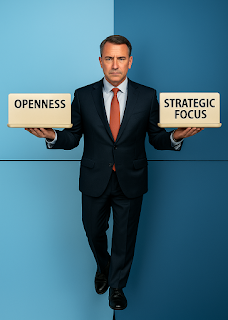But what happens when transparency is interpreted as “tell
me everything, all the time”?
This is the tension many leaders face. The desire for
openness can sometimes morph into a culture of over-disclosure, where
colleagues expect to be looped into every decision, every nuance, every draft.
And while inclusivity is vital, so is clarity of purpose.
Here’s how I think about navigating this balance:
1. Define What Transparency Is—and Isn’t
Not long ago, a few team members expressed frustration that
they hadn’t been informed about a personnel change until after the action had
been finalized. Their concern was rooted in a genuine desire to feel included
and informed. But it also revealed a common misconception: that transparency
means real-time access to every decision as it unfolds.
I reflected on that moment a lot. The truth is, there are
times when we simply can’t share everything, especially when it involves
sensitive personnel matters. Transparency doesn’t mean violating
confidentiality or prematurely disclosing decisions that are still in motion.
It means sharing what we can, when we can, with honesty and context.
This tension is often amplified by generational
expectations. For example, younger colleagues raised in an era of open-source
collaboration and instant updates may expect a level of visibility that feels
excessive to more seasoned professionals who were trained to compartmentalize
information until it’s fully baked. Neither perspective is wrong, but they do
require calibration.
Transparency, in this sense, is not about omniscience; it’s
about trust. It’s about ensuring that when we do communicate, it’s with
clarity, purpose, and respect for all involved.
2. Anchor Communication in Purpose
When we communicate, we should ask: What does this person
need to know to do their job well? Not: What do I know that I haven’t
shared yet? This shift keeps transparency aligned with action.
I remember a time when we rolled out a new reporting tool. A
Gen Z analyst asked why they hadn’t been included in the early planning
meetings. Meanwhile, a Gen X team lead said, “Just tell me when it’s live.”
Same project, different expectations. We realized we needed to clarify not just
what we were doing, but why certain people were involved at different stages.
Purpose-driven communication helped us bridge that gap. We
didn’t need to loop everyone into every meeting; we just needed to explain the
roadmap and how each role fit into it.
3. Use Transparency to Build Trust, Not Noise
Trust grows when people feel informed, not overwhelmed. That
means being honest about challenges, clear about direction, and intentional
about what’s shared. Oversharing can dilute focus and create confusion.
This is especially important in multigenerational teams.
Millennials may interpret silence as secrecy, while Boomers may see constant
updates as a distraction. The goal is to build a rhythm of communication that
respects both preferences.
A few years ago, we tried a “radical transparency”
experiment by opening up all project dashboards to the entire department.
Within weeks, we were fielding questions about line items that had nothing to
do with most people’s work. It created anxiety, not alignment.
We learned that transparency without context is just noise.
Now, we focus on curating what’s shared, providing the right level of detail for
the right audience. That’s what builds trust.
4. Create Channels, Not Floodgates
Structured updates, regular check-ins, and accessible
documentation can satisfy the need for visibility without turning every
conversation into a town hall. Transparency thrives in systems, not in
spontaneity alone.
During a cross-generational team project, we noticed that
our younger staff preferred real-time updates in Teams, while others wanted a
weekly summary email. We ended up creating a shared OneNote with key decisions
and action items, updated weekly, and linked in both formats.
It wasn’t flashy, but it worked. Everyone had access to the
same information, in the way they preferred to consume it. That’s the kind of
channel-building that supports sustainable transparency.
And those systems should be flexible enough to meet people
where they are. A Gen Z team member might prefer a shared dashboard or
real-time doc, while a Gen X colleague might appreciate a weekly digest. The
medium matters as much as the message.
5. Model the Balance
As leaders, we set the tone. When we’re thoughtful about
what we share and when we teach others to do the same. We show that
transparency is a tool, not a trap.
I once had a direct report who was hesitant to hold back
information, fearing it would be seen as secretive. We talked about the
difference between being transparent and being indiscriminate. I shared how I
decide what to communicate: Is it actionable? Is it timely? Is it respectful of
others?
That conversation helped them find their own balance, and it
reminded me that modeling transparency isn’t just about what we say. It’s about
how we think.
In the end, transparency isn’t about knowing everything.
It’s about knowing enough to move forward together with empathy, intention, and
respect for the diverse ways our colleagues process information.



